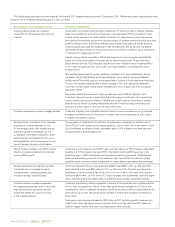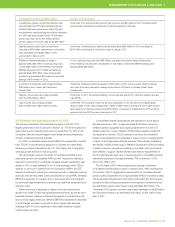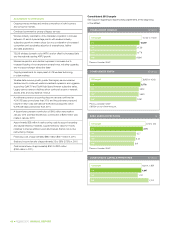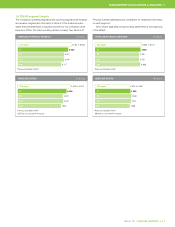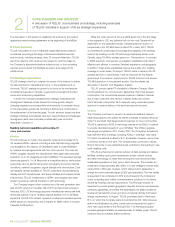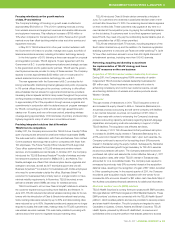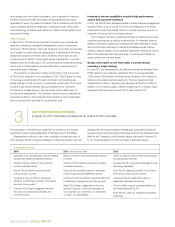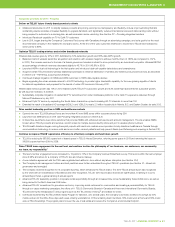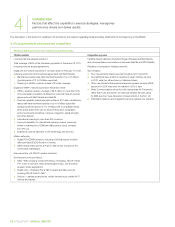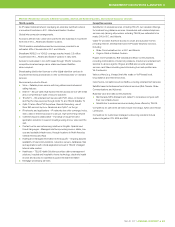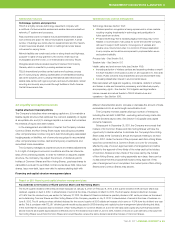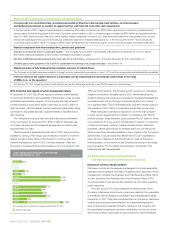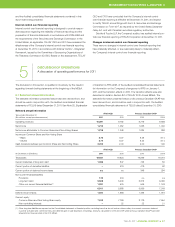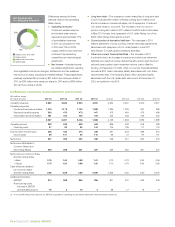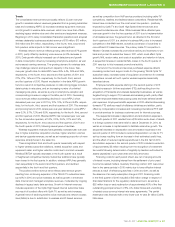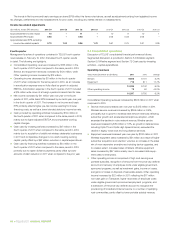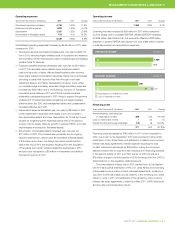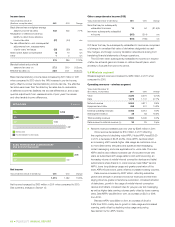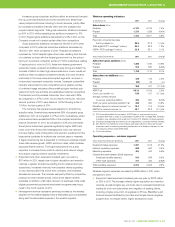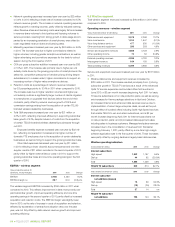Telus 2011 Annual Report Download - page 58
Download and view the complete annual report
Please find page 58 of the 2011 Telus annual report below. You can navigate through the pages in the report by either clicking on the pages listed below, or by using the keyword search tool below to find specific information within the annual report.
54 . TELUS 2011 ANNUAL REPORT
4.2 Operational resources
Operational resources Operational risks and risk management
People
At the end of 2011, the Company employed approximately 41,100 TELUS
team members (40,100 full-time equivalent or FTE employees) across
a wide range of operational functions domestically and certain functions
internationally.
Contact centre operations at Canadian and international locations support
business process outsourcing services for external wholesale customers.
The Company also uses offshore services for certain internal operations
to improve efficiency and to allow onshore operations to focus on value-
added services.
Employee compensation programs support a high-performance culture
and contain market-driven and performance-based components.
The Company expects that it has adequate employee resources to cover
ongoing retirement, and ready access to labour in Canada and, for call
centres and specific support functions, various locations internationally.
TELUS uses a small number of external contractors or consultants.
The Company has training, mentoring and development programs in place,
such as Connections – the TELUS women’s network, a national initiative
that supports the advancement of business expertise, mentoring and
networking opportunities for women across the country.
Employee compensation, retention and labour relations risks
(see Section 10.4 Human resources):
.Approximately 12,800 team members are covered by a collective
agreement. The collective agreement with the Syndicat des agents de
maîtrise de TELUS (SAMT), representing approximately 510 members,
expired on December 31, 2011. The collective agreement with the
Telecommunications Workers Union (TWU), covering approximately
11,250 employees, is in effect through 2015
.Retention and hiring issues are expected to remain due to an increase
in the number of competitors
.TELUS aims to attract and retain key employees through both monetary
and non-monetary approaches, striving to protect and improve
engagement levels
.The Company altered weightings of its performance-based measures
to place greater emphasis on corporate-wide and individual perfor-
mance, beginning in 2010.
Foreign operations (see Section 10.5 Process risks):
.TELUS International employs approximately 13,200 team members.
This is an increase of 4,800 in 2011 due largely to the purchase of
control of Transactel.
General safety risks – See Section 10.8 Health, safety and environment.
Brand and distribution
The Company has a well established and recognizable national brand
(TELUS, the future is friendly®) that is supported by extensive advertising
across all media.
Optik TV and Optik High Speed Internet brands launched in mid-2010.
Koodo Mobile® basic wireless brand and postpaid service introduced
in March 2008.
Niche-market brand CAYATM (come as you are) and stores introduced
in late 2010 for lesbian, gay, bisexual and transgender customers,
among others.
Sales and support distribution:
.Wireless services supported through a broad network of TELUS-owned
and branded stores (including Black’s Photo stores), an extensive
distribution network of exclusive dealers and large third-party electronics
retailers (e.g. Future Shop / Best Buy, Wal-Mart and London Drugs),
as well as online self-serve applications
.Business services across wireless and wireline supported through
TELUS sales representatives, SMB zones within certain corporate
stores, 10 TELUS Business Stores and independent dealers
.Wireline residential services supported through mass-marketing
campaigns, client care telephone agents and online self-serve
applications.
Competition risks – See Section 10.1.
Competition overview – See Section 4.1.
Industry and economy – See Section 9: General outlook and Section 10.11
Economic growth and fluctuations.
Regulatory risks (see Section 10.3) include:
.Competitors in the broadcasting distribution industry own broad casting
content, while TELUS does not. However, in 2011 the CRTC enacted a
vertical integration framework that set safeguards to ensure competition
and prohibit TV offerings on an exclusive basis on all platforms
.Foreign ownership restrictions generally apply to wireless telecom-
munications companies, as well as to facilities-based wireline
telecommunications companies and to broadcasting distribution
undertakings
.The design of future wireless spectrum auctions, such as for the
700 MHz and 2.5/2.6 GHz ranges, may be unfavourable to TELUS,
making the cost of acquiring or availability of future spectrum
uncertain for TELUS.


